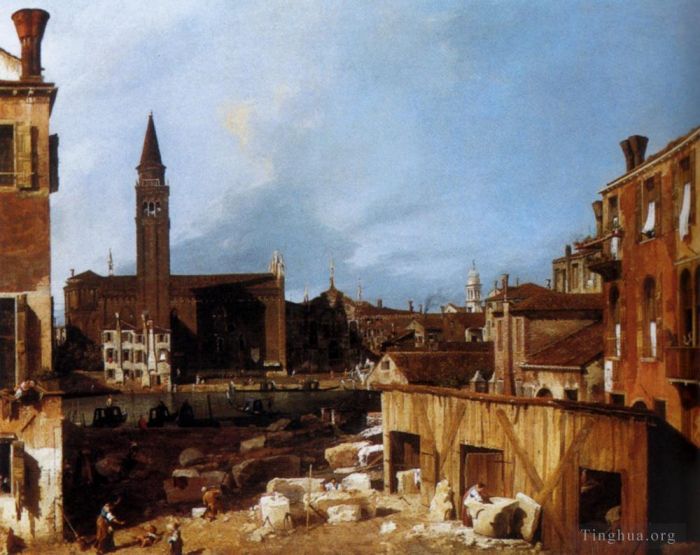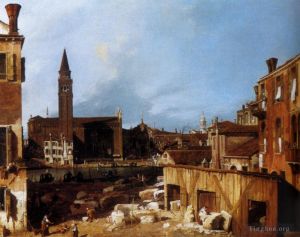Stonemasons Yard
Canaletto
- Price: Price on Request
- Art Type: Oil Painting
- Size:
- English Comments: 0
- International Comments: 0
- Creating Date:
- Introduction and Works of Canaletto >>
Keywords:
Stonemasons, Yard
Work Overview
- The Stonemason's Yard
Artist Canaletto
Year c. 1725
Medium Oil on canvas
Dimensions 124 cm × 163 cm (49 in × 64 in)
Location National Gallery, London, UK
The Stonemason's Yard (formally known as Campo S. Vidal and Santa Maria della Carità) is an early oil painting by Giovanni Antonio Canal, better known as Canaletto. Painted in the mid to late 1720s, it is considered one of Canaletto's finest works.
The painting, 123.8 cm tall and 162.9 cm wide,[2] depicts a Venetian scene looking roughly southwest over a temporary stonemason's yard situated in an open space beside the Grand Canal known as the Campo San Vidal ("campo", literally field, used in Venice to denote a small open space). Several masons are at work shaping and carving stone probably destined for the reconstruction of the nearby church of San Vidal (immediately behind the viewer and so not visible in the painting; its Palladian façade was renovated in the 1730s) or possibly for the embellishment of a nearby palazzo (the Palazzo Cavalli-Franchetti and Palazzo Barbaro are close by, to the viewer's left). The side of the medieval church of Santa Maria della Carità, reconstructed in the 1440s, stands on the opposite bank of the Grand Canal, to the left of the façade of the Scuola Grande della Carità; the tower of the church of San Trovaso is visible rising over the rooftops in the distance.
In addition to the architectural details, The Stonemason's Yard shows scenes of daily life in Venice, probably in the early morning: a cock crows on a windowsill to the lower left, and sunlight streams in from the left behind the viewer's (east). The mainly domestic buildings are generally in poor repair, with typical Venetian flared chimney-pots. Laundry hangs from many of the windows, and pot plants stand on several balconies. One woman is using a distaff and drop spindle to spin thread on a balcony to the right; another draws water from a well in the campo beside a wooden shed, from a well-head shaped like the capital of a column. Two children are playing in the foreground to the left: one is falling over and urinating involuntarily in surprise, as a woman lunges forward to catch him; another woman looks down from a balcony above. A gondola with canopied cabin passes on the canal, with others moored on either bank.
Unsigned and undated, the painting is attributed and dated by stylistic clues. The informal scene is thought to have been painted for a Venetian patron, rather than a foreign visitor to Venice, in the mid to late 1720s.[1]
Unlike many views painted by Canaletto and his fellow vedutisti, the location has changed significantly since the 1720s. The view of the opposite bank of the Grand Canal is now blocked by the high arch of the modern wooden Accademia bridge, and the church of the Carità has been much altered. The campanile fell down in the 1740s, demolishing the houses beside the canal in front, and much of the other stonework has been removed. The nave became the Accademia di Belle Arti di Venezia in the 1800s, and the Gallerie dell'Accademia is housed in the Scuola. The Campo remains an open space, with the well-head at its centre. The domestic building to the right remains standing.[3]
The Stonemason's Yard is an early example of using Prussian blue in oil painting.[4] Canaletto painted The Stonemason's Yard around 1725 while Prussian blue was discovered by Diesbach in 1704. Amongst other pigments used by Canaletto in this painting were Naples yellow, lead white and ochres.[5]
The Stonemason's Yard was one of the paintings donated to the nation by Sir George Beaumont in 1823 to form the nucleus of the National Gallery's nascent collection. It passed to the National Gallery in 1828, where it continues to be exhibited.
Giovanni Antonio Canal's popularity with English Grand Tourists - mainly young noblemen completing their education with an extended trip to the Continent - has meant that many more of his pictures can be found in Britain than in his native Venice or even throughout Italy. Trained as a scene painter, by 1725 he was specialising in vedute - more or less topographically exact records of the city, its canals and churches, festivals and ceremonies. He visited England several times, but his English paintings did not please, and he returned home for good in about 1756.
Although we associate Canaletto for the most part with mass-produced, crystal-clear scenes of celebrated sights, the 'Stonemason's Yard', his masterpiece, is not of this kind. A comparatively early picture, and almost certainly made to order for a Venetian client, it presents an intimate view of the city, as if from a rear window. The site is not in fact a mason's yard, but the Campo San Vidal during re-building operations on the adjoining church of San Vidal or Vitale. Santa Maria della Carità, now the Accademia di Belle Arti, the main art gallery in Venice, is the church seen across the Grand Canal.The Church of Santa Maria della Carità is still flanked by the slender campanile that collapsed in 1741.
Canaletto's later works are painted rather tightly on a reflective white ground, but this picture was freely brushed over reddish brown, the technical reason for the warm tonality of the whole. Thundery clouds are gradually clearing, and the sun casts powerful shadows, whose steep diagonals help define the space and articulate the architecture. Not doges and dignitaries but the working people and children of Venice animate the scene and set the scale. In the left foreground a mother has propped up her broom to rush to the aid of her fallen and incontinent toddler, watched by a woman airing the bedding out of the window above and a serious little girl. Stonemasons kneel to their work. A woman sits spinning at her window. The city, weatherbeaten, dilapidated, lives on, and below the high bell-tower of Santa Maria della Carità it is the little shabby house, with a brave red cloth hanging from the window, which catches the brightest of the sunlight.
'The Stonemason's Yard' is considered one of Canaletto's finest works. The view is one across the Campo (small square) S. Vidal, looking over the Grand Canal to the church of S. Maria della Carità (Saint Mary of Charity). The square has been temporarily transformed into a workshop for repairing the nearby church (not seen in the picture) of S. Vidal. The blocks of Istrian stone were brought by water to the square. The 'campanile' (bell-tower) of the church of S. Maria della Carità on the far side of the Grand Canal collapsed in 1744, after the painting was made, and was not rebuilt.
The painting is not precisely datable but the bold composition, the densely applied paint and the careful execution of the figures are characteristic of Canaletto's works of the mid- to late 1720s. The informal nature of the scene and the unusual view across the Grand Canal suggest that it was made for a local Venetian patron rather than a foreign visitor to Venice.
- Copyright Statement:
All the reproduction of any forms about this work unauthorized by Singing Palette including images, texts and so on will be deemed to be violating the Copyright Laws.
To cite this webpage, please link back here.
- >> English Comments
- >> Chinese Comments
- >> French Comments
- >> German Comments
- >>Report
- Capriccio with ruins and porta portello in padua
- The women s regaton the grand canal
- The campo di rialto
- The Eastern Facade Of Warwick Castle
- Riva degli Schiavoni west side
- The piazzetta towards san giorgio maggiore
- Doge Palace
- Santa Maria Zobenigo
- Grand Canal
- San Giacomo Di Rialto
- The Piazzetta
- Capriccio with classical ruins and buildings
- Grand Canal From Santa Maria Della Carita To The Bacino Di San Marco
- Basilica di vecenza and the ponte de rialto
- Capriccio of a round church with an elaborate gothic portico in a piazza a palladian piazza and 1755
- Piazza San Marco Venice (Piazza San Marco with the Basilica)
- The Nave of San Marco looking East (San Marco the Interior)
- Warwick castle
- The Bucintoro Returning To The Molo On Ascension Day
- A Regatta on the Grand Canal
- Venice Viewed from the San Giorgio Maggiore
- View of the Ducal Palace
- Piazza san marco looking east
- The Bacino di San Marco on Ascension Day
- View Of the Entrance To The Arsenal
- Dolo On The Brenta Venetian Venice
- The Molo Looking West
- Palazzo Ducale and the Piazza di San Marco
- Grand Canal The Rialto Bridge From The South
- Scala dei giganti 1765
- The Riva Degli Schiavoni
- Rio Dei Mendicanti
- The interior of henry vii chapel in westminster abbey
- View of the grand walk vauxhall gardens with the orchestra pavilion the organ house the turkish
- Perspective View with Portico
- Stonemasons Yard
- View of the Bacino di San Marco St Marks Basin
- Perspective with a portico 1765
- The thames with st pauls cathedral 1746
- Piazza San Marco 1730
- Reception Of The Ambassador In The Doges Palace
- Dolo on the brenta
- Return Of The Bucentoro To The Molo On Ascension Day
- The chapel of eton college 1747
- The Grand Canal From Rialto Toward The North
- The Grand Canal with the Rialto Bridge in the Background
- View Of Campo Santi Apostoli
- Perspective view with portico
- Capriccio of the grand canal with an imaginary rialto bridge and other buildings
- London Interior of the Rotunda at Ranelagh
- The Grand Canal looking East from Campo San Vio towards the Bacino
- The Fonteghetto Della Farina
- The Piazzetta towards S. Giorgio Maggiore
- The thames and the city of london from richmond house 1746
- Campo san rocco
- Night time celebration outside the church of san pietro di castello
- The Stonemasons Yard
- Canal Giovanni Antonio View Of The Grand Canal And Santa Maria Della Salute With Boats And Figure
- The Piazzetta towards Santa Maria della Salute
- Piazza San Marco The Clocktower
- Capriccio of a renaissance triumphal arch seen from the portico of a palace 1755
- Bacino di San Marco St Marks Basin
- San francesco della vigna church and campo
- Entrance To The Grand Canal Looking East
- Alnwick castle
- Piazza San Marco Looking Southeast
- Westminster abbey with a procession of knights of the bath 1749
- CANALETTO Grand Canal Looking Northeast From Palazo Balbi Toward The Rial to Bridge
- The Feast Day of St Roch
- Arrival of the French Ambassador in Venice
- CANALETTO Grand Canal Looking East From The Campo San Vio
- Capriccio Ruins And Classic Buildings
- The Entrance to the Grand Canal Venice
- A Regatta on the Grand Canal
- English Landscape Capriccio with a Column
- The dogana in Venice (Punta della Dogana in Venice)
- Santi Giovanni E Paolo And The Scuola Di San Marco 1726
- Campo santa maria formosa
- The Piazza San Marco in Venice
- San Cristoforo San Michele and Murano from the Fondamenta Nuove Venice
- The Grand Canal with Santa Maria della Salute looking East towards the Bacino
- Rome the arch of constantine 1742
- Santi Giovanni e Paolo and the Scuola de San Marco
- The Grand Canal near the Ponte di Rialto
- Venice Piazza San Marco and the Colonnade of the Procuratie Nuove









 Singing Palette
Singing Palette